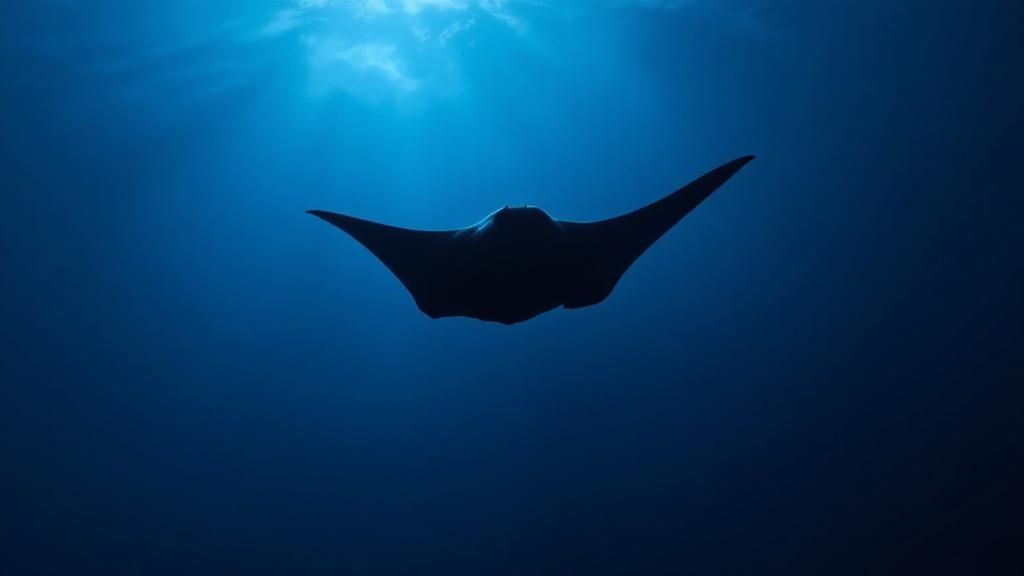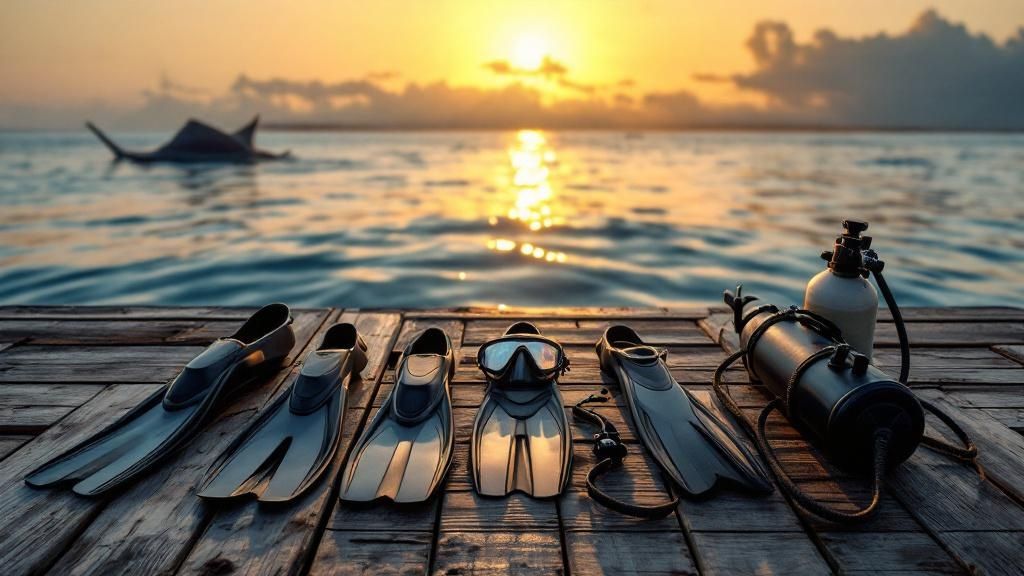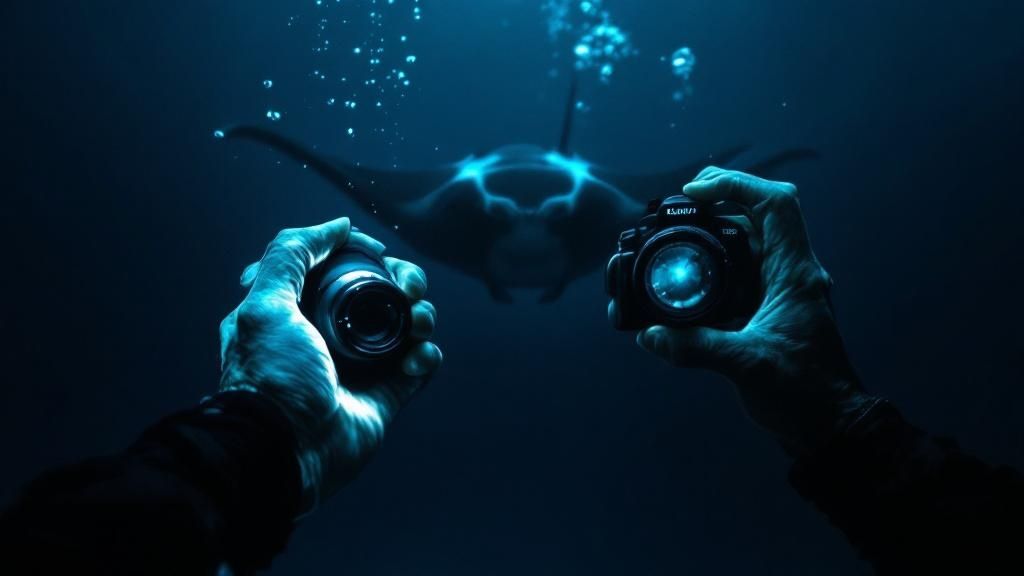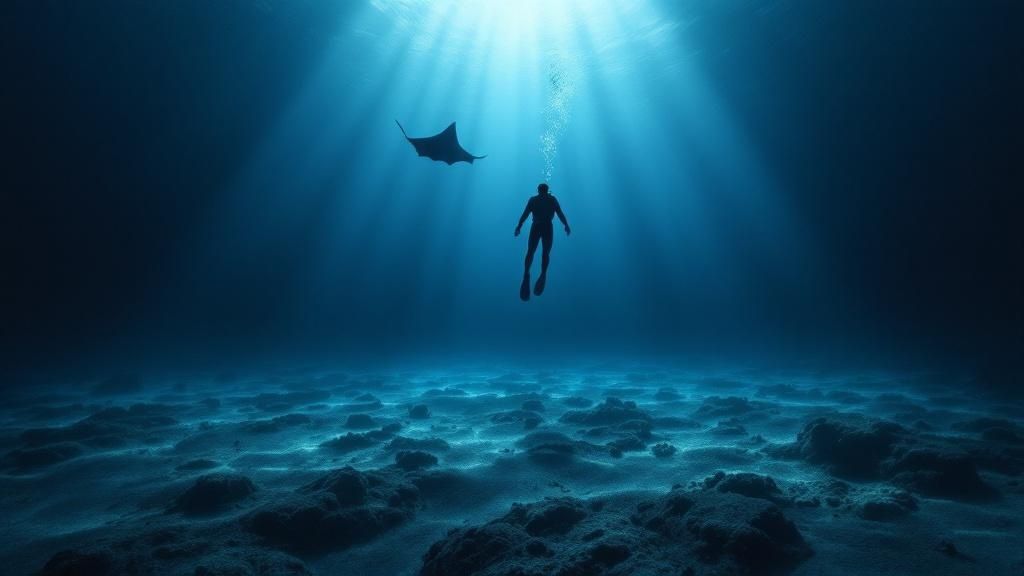Picture this: you’re floating in the warm, dark waters of the Pacific Ocean off the Kona coast. Suddenly, a colossal, graceful shadow emerges from the deep. An enormous manta ray, with a wingspan stretching up to 18 feet, glides silently, just inches from your face. This isn't a scene from a documentary—it's the world-famous manta ray dive in Kona, an underwater ballet that many divers call one of the most incredible wildlife encounters on Earth.
If this adventure is on your bucket list, you've picked the right place. Kona offers one of the most reliable and genuinely breathtaking manta experiences you can find anywhere.
What Makes the Kona Manta Ray Dive So Unique

The Kona manta ray dive isn't just another checklist item for your Hawaiian vacation; it's a beautifully orchestrated natural event. The whole experience hinges on a brilliantly simple idea: light attracts life. Once the sun goes down, dive operators submerge powerful lights into the water. These lights illuminate the ocean, drawing in clouds of microscopic plankton—the manta rays' favorite meal.
This glowing plankton soup essentially rings a dinner bell for Kona's resident manta population. Before you know it, dozens of these gentle giants arrive for the feast, creating a feeding frenzy that is nothing short of spectacular. For divers and snorkelers, this means you get a front-row seat to one of nature's most awesome shows.
Here's a quick look at the key details.
Kona Manta Ray Dive at a Glance
| Aspect | Details |
|---|---|
| Location | Kona Coast, Big Island of Hawaii |
| Best Time | Year-round, after sunset |
| Average Wingspan | 8-12 feet, with some reaching 18 feet |
| Success Rate | Over 90% chance of seeing mantas |
| Key Attraction | Plankton attracted by submerged lights |
| Activities | Scuba Diving and Snorkeling |
This table gives you the basics, but the real magic is in the experience itself.
An Underwater Ballet of Gentle Giants
As the mantas show up, they put on a true performance. They perform these incredible acrobatics, swooping, and barrel-rolling right through the light beams to gulp down the plankton. They move with such grace, sometimes passing just inches away from you as you watch from the ocean floor or float on the surface. It’s this up-close-and-personal interaction, plus the sheer number of mantas, that makes the Kona experience so different from anywhere else in the world.
The magic is truly in the interaction. You aren't just a spectator watching from a boat. You become part of the underwater scenery as these massive, intelligent creatures perform a silent, choreographed dance all around you.
Unlike a lot of wildlife tours where sightings are left to chance, the Kona manta dive has an unbelievably high success rate—often topping 90%. This is all thanks to the well-established feeding sites and the local manta population, who have figured out that lights mean an easy dinner. To get a real feel for what makes this so special, you should see why it's considered one of Big Island's best adventures: Manta Ray Snorkel Kona.
It’s this perfect storm of factors that makes the Kona manta ray dive an absolute must-do, creating the kind of memories that will stick with you forever.
Why Kona Is the World's Best Place to See Manta Rays

You can find manta rays in a lot of places around the globe, but what we have here on the Kona coast is something truly special. This isn't just a lucky spot; it's a unique intersection of geography and animal behavior that makes for an incredible, year-round spectacle. It's why so many people say a manta ray dive in Kona is the best in the world.
The magic ingredient? A reliable food source. Kona’s manta rays are residents, not just passing through. They’ve figured out that the lights from divers and snorkelers attract plankton, their favorite food. This creates a nightly, all-you-can-eat buffet in the same few spots, and the mantas show up consistently for dinner.
What Makes Kona’s Manta Encounters So Reliable?
This predictability is what really sets Kona apart. Many other manta hotspots are centered around "cleaning stations," where mantas go to have smaller fish clean parasites off their skin. While fascinating, it's often a more passive experience. Here, you're witnessing a full-blown feeding frenzy, which is a far more dynamic and breathtaking show.
So, how did Kona get so lucky? It comes down to a few key advantages:
- A Perfect Coastline: The volcanic underwater landscape has created naturally sheltered bays, protecting our dive sites from the rough open ocean.
- Constant Food Supply: Local currents keep the water rich in nutrients, which means there's always a healthy population of plankton for the mantas to feed on.
- A Learned Tradition: This isn't a new phenomenon. For decades, Kona's mantas have been conditioned to associate light with an easy meal, a behavior passed down through generations.
This combination leads to an unbelievably high success rate for seeing mantas. We aren't just guessing, either. A multi-year study confirmed Kona's dominance, finding an average of 20 manta sightings per night here, compared to about 10 elsewhere. The study also noted our average visibility is an amazing 100 feet, making the show crystal clear.
What you get isn't just a dive; it's a front-row seat to a natural event that happens like clockwork. That consistency is what turns a hopeful wildlife tour into an almost guaranteed, awe-inspiring performance.
Because the mantas are here all year long, the biggest thing to think about when you're planning your trip is the weather, not the animals. For a deeper dive into that, take a look at our guide on the best time of year to see manta rays in Kona. It's this perfect storm of ideal conditions and a reliable resident population that truly makes Kona the undisputed capital for manta ray encounters.
Choosing the Right Manta Ray Dive Site for You

So, you're ready to dive with Kona's famous manta rays. The first big decision you'll make is choosing where to go. You've got two main options, and they each offer a completely different vibe. Think of it as choosing between a cozy, intimate theatre and a big, bustling concert hall—both put on an incredible show, but the experience itself feels worlds apart.
Your choice boils down to two world-renowned sites: Manta Village in Keauhou Bay and Manta Heaven, which is closer to the airport. These spots are so reliable and spectacular that they draw a combined 80,000 visitors every single year, cementing Kona's reputation as the place for manta encounters. While you really can't go wrong with either, knowing the differences will help you pick the perfect adventure for your skill and comfort level. You can get an even deeper look into this incredible Big Island attraction at Kona Honu Divers.
Manta Village: The Classic Campfire
Manta Village, nestled in the protected waters of Keauhou Bay, is the original manta ray night dive. It’s been the go-to spot for decades. The dive itself is relatively shallow, usually around 30-40 feet, and the bay's geography keeps the water calm and predictable. This makes it a fantastic choice if you're a first-time night diver, a snorkeler, or just a little anxious about being in the open ocean after dark.
We call this experience the "campfire." Divers and snorkelers gather in a circle on the sandy bottom, pointing their flashlights up. This creates a cone of light that acts like a bug zapper for plankton, drawing them in. Before you know it, the mantas arrive, swooping and gliding through the light beams to feed. It’s a breathtaking ballet happening right above your head.
Manta Village provides a beautifully controlled and predictable environment. It’s like having the best seat in the house for a spectacular performance, allowing you to simply relax and be mesmerized by the show.
Manta Heaven: The Adventurous Encounter
Head a bit further north, up near the Kona International Airport, and you'll find Manta Heaven. This dive site is a bit deeper, with the bottom sitting at about 40-50 feet, and it can sometimes experience stronger currents. Because of this, it tends to attract more confident, experienced divers who are up for a slightly wilder ride.
The conditions at Manta Heaven often lead to more dynamic encounters. The mantas might swoop in closer, the interactions can feel more personal, and the whole experience feels a bit more untamed. If you’re a seasoned diver who’s comfortable with a little more motion and unpredictability in the water, this site often delivers a truly heart-pounding and unforgettable show.
A Step-by-Step Guide to Your Dive Adventure

So, you’re ready for the adventure of a lifetime, but what does the evening actually look like? Knowing what to expect from start to finish helps you relax and soak in every incredible moment. Your journey begins the moment you check in with our crew.
After a warm aloha and welcome aboard, we'll walk you through a detailed safety briefing. This is a vital part of the tour where we cover the boat's layout, the dive plan, and—most importantly—how we all interact with the mantas respectfully. We’ll explain everything from entering the water to our strict passive observation rules. Remember: no touching, no chasing. This ensures we protect these magnificent creatures and their habitat.
The Journey to the Campfire
Once the briefing is done and everyone's geared up, we'll head out to one of Kona's world-famous manta sites. The boat ride itself is a treat, often timed perfectly to catch a spectacular sunset over the Pacific. As we arrive and the sun dips below the horizon, the real show is about to begin.
Your guide will lead the group into the water and down to a pre-selected spot on the sandy ocean floor, usually in water around 30-40 feet deep. This is where we gather in a semi-circle around a powerful, stationary light source we affectionately call the "campfire."
The underwater campfire is the heart of the entire experience. It’s a custom-built light box that shines up towards the surface, attracting a massive cloud of plankton—the manta rays’ favorite food. Essentially, we're ringing the dinner bell.
You’ll find your spot on the sand, get comfortable, and point your own dive light straight up, adding to the beacon. The water above you begins to glow, and before long, you’ll spot graceful shadows gliding in from the darkness. The first time you see a manta ray appear is a moment you will never forget. They swoop and soar just inches overhead, performing effortless barrel rolls as they feed on the plankton concentrated in the light beams.
To really understand what makes this underwater ballet so captivating, you can discover more about why you should go on a manta ray dive in Kona.
How to Be a Responsible Manta Ray Viewer
Getting to witness the Kona manta ray dive is a privilege, and with that comes a genuine responsibility to protect these incredible animals. The entire experience hinges on one simple, non-negotiable principle: passive observation.
Think of it like being a guest in someone’s home. You’d admire the decor, but you wouldn’t go around touching everything. It's the same underwater. Touching a manta ray can actually remove its protective mucus layer, which is like its immune system, leaving it exposed to nasty skin infections.
The Core Rules of Engagement
Every good dive guide will run you through the rules, but a few core principles are universal for any responsible operator. Sticking to them is what keeps this incredible encounter safe and sustainable for everyone—especially the mantas.
- Observe Only: This is the big one. Absolutely no touching, no chasing, and definitely no trying to "ride" a manta. Let them be the ones to decide how close they get.
- Hold Your Position: If you're diving, your spot is on or near the sandy bottom. If you're snorkeling, you stay on the surface. This creates a clear, predictable space for the mantas to gracefully swim and feed.
- Mind Your Bubbles: Divers, try your best not to exhale right as a manta is passing directly overhead. It can be startling for them.
Following these simple guidelines ensures the Kona manta ray dive remains a magical—and sustainable—experience for years to come. You can learn more about what to expect on our manta ray night dive in Kailua Kona.
"The entire manta ray viewing industry in Kona is built on a delicate balance between human interaction and animal welfare. When you choose a responsible operator, you're not just buying a ticket to a show; you're casting a vote to protect these gentle giants for future generations."
The manta ray night diving industry is a cornerstone of the Kona Coast's economy, focused mainly on two sites: Manta Village and Manta Heaven. These locations have been carefully assessed and deemed safe for sustainable tourism, thanks to their calm conditions and the reliable presence of mantas. Detailed studies on these findings on sustainable manta operations confirm that when done right, we can all enjoy this spectacle without harming the main attraction.
Planning Your Trip: Your Questions Answered
Getting ready for a manta ray dive in Kona is exciting, but it’s natural to have a few questions before you take the plunge. We get it. To make sure you feel totally prepared for this once-in-a-lifetime wildlife encounter, we've put together answers to the most common questions we hear from our guests.
First things first: do you need to be a scuba diver? Absolutely not! The beauty of this experience is that it’s for everyone. Snorkeling is just as popular and gives you a spectacular view from the surface as the mantas feed and somersault just a few feet below you.
When Is the Best Time to See the Mantas?
This is one of the best parts—the mantas are here all the time! Kona’s manta rays are year-round residents, so you can book a tour any month and have an excellent chance of seeing them. Our sighting success rate consistently tops 90%, no matter the season.
If you're trying to pick the "perfect" time, your decision really comes down to weather. The summer months generally bring calmer ocean conditions, but the mantas are always here, waiting to put on their nightly show.
How Close Will I Get?
Prepare to be amazed. The mantas get incredibly close. It's totally normal for these gentle giants, with wingspans often reaching 8-12 feet, to glide within inches of you. They're completely focused on feeding on the plankton attracted by our lights, creating a mesmerizing and perfectly safe underwater ballet.
Is the Manta Ray Night Dive Safe for Beginners?
Yes, this is a very safe and beginner-friendly activity. We run our tours in shallow, protected bays, and our crew follows strict safety protocols. Before you even get in the water, your guide will walk you through a detailed briefing to make sure you’re comfortable and know exactly what to expect.
The entire experience is designed to inspire awe, not fear. We create a calm, controlled environment where you can simply float and watch the magic unfold. It's all about passive observation, letting you relax as these graceful creatures soar around you.
What Should I Bring on the Boat?
A little preparation goes a long way to ensure you have a comfortable trip. Here are a few essentials to pack:
- A towel and a dry change of clothes. You’ll be happy to have something warm to slip into after your swim.
- A sweatshirt or light jacket. Even on a warm Hawaiian evening, the boat ride back can get a bit chilly.
- Any personal medications. If you're prone to seasickness, it's a good idea to take something beforehand.
- A reusable water bottle. It's always smart to stay hydrated.
While you’re planning your water adventures in Kona, don't stop with the mantas! The Big Island has so much to offer. For another fantastic day on the water, check out this ultimate guide to snorkeling Captain Cook in Kona and make the most of your trip.
Ready to see the world-famous underwater ballet for yourself? Kona Honu Divers offers expertly guided manta ray tours for both snorkelers and divers. Book your unforgettable manta ray adventure with us today!
